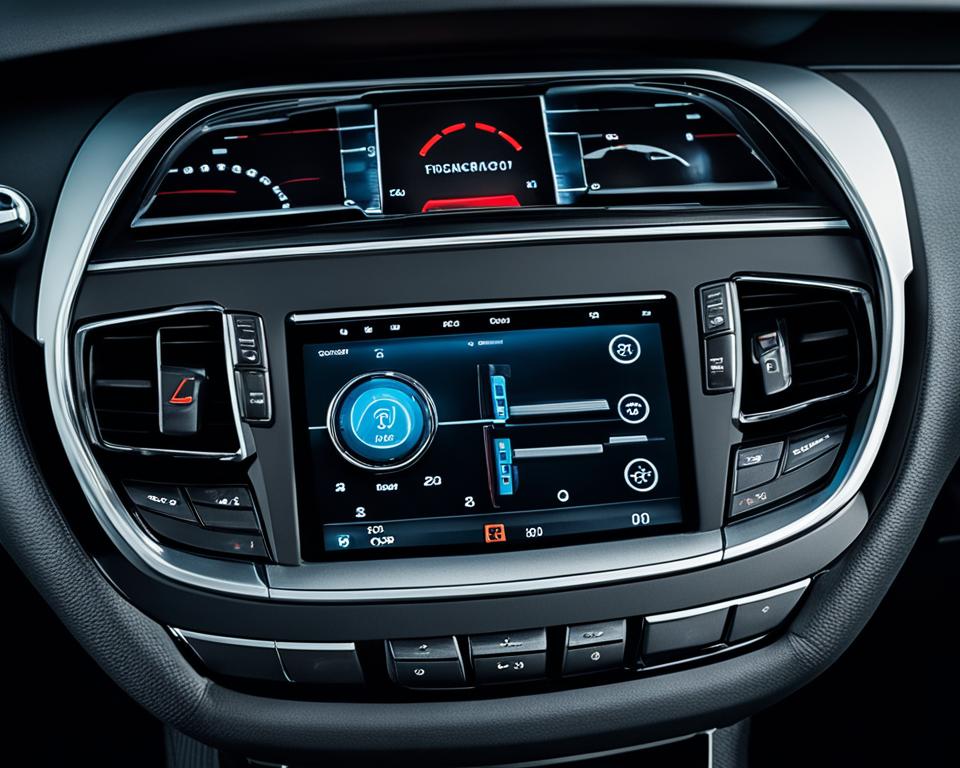The rise of automatic cars has changed how we view driving today. These cars come with advanced tech that makes driving safer and easier. They offer a new way to travel that’s safer, more convenient, and smoother.
This guide is here to help beginners get started with automatic cars. We’ll cover the basics, what makes them tick, and how they work. It’s your first step into the world of automatic cars.
Read interesting things at : apportfolioasia
Key Takeaways
- Automatic cars use tech to make driving safer and easier.
- It’s important for beginners to know the different levels of automation.
- These cars bring many benefits, like better safety and more mobility.
- Things like sensors and artificial intelligence are key to how they work.
- Learning about the tech and starting with automated driving is a good start for beginners.
What is an Automatic Car?
An automatic car is a new way to travel that’s changing how we drive. It uses technology to drive itself, making roads safer and easier to navigate. These cars use advanced tech to move and make decisions without much human help.
Understanding Autonomous Driving Technology
Automatic cars have a system of sensors, cameras, and smart software. They work together to see the world around them, decide what to do, and move on their own. This tech is getting better all the time, thanks to new advances in learning machines and artificial intelligence.
Levels of Automation in Vehicles
Automatic cars vary in how much they can do on their own. They range from simple driver aids to cars that drive by themselves. These levels go from Level 1 (just helps with simple tasks) to Level 5 (drives all by itself).
| Level | Description |
|---|---|
| Level 1 | Driver assistance features, such as adaptive cruise control or lane-keeping assistance. |
| Level 2 | Partial automation, where the vehicle can control both steering and acceleration/deceleration under certain conditions. |
| Level 3 | Conditional automation, where the vehicle can handle most driving tasks, but the driver must be ready to take control. |
| Level 4 | High automation, where the vehicle can perform all driving tasks without human intervention in specific geographic areas or conditions. |
| Level 5 | Full automation, where the vehicle can operate without a human driver under all circumstances. |
As we keep improving autonomous driving tech, we’ll see more cars that drive themselves. Soon, fully automated cars might be a common sight on our roads.
Benefits of Automatic Cars
The world is moving towards automatic cars for beginners, and it’s clear why. These cars bring many benefits, like better safety and easier driving. The beginner’s guide to auto automation is changing the car industry for the better.
Improved Safety
Car automation for newbies means safer driving. Automatic cars use sensors and AI to spot dangers before they happen. This cuts down on accidents caused by things like texting or being drunk while driving.
Enhanced Mobility
Automatic cars also make driving easier for people who can’t drive regular cars. They open up the world of driving to more people. This means more freedom and independence for those who couldn’t drive before.
| Benefit | Description |
|---|---|
| Improved Safety | Automatic cars have sensors and AI to spot dangers fast. This lowers the chance of accidents. |
| Enhanced Mobility | Automatic cars make driving easier for people with disabilities. This improves their life and freedom. |
“The future of driving lies in the seamless integration of automation and human expertise, creating a safer and more accessible transportation experience.”
The automatic car for beginners technology is getting better all the time. It’s changing how we see driving and getting around.
Key Components of Automatic Cars
The rise of automated vehicles has changed the way we travel. At the core of these cars are advanced technologies that work together for self-driving. Let’s look at the key components that make these cars possible.
The sensor system is a vital part. These cars have cameras, radar, and LIDAR sensors. They scan the area, spotting obstacles, people, and other cars. This helps the car’s computer understand what’s around it, making safe decisions.
The computer system is also key. It uses smart technology and learning algorithms. This system controls the car’s actions, like speed and braking, based on the road conditions. The software in this system is crucial for the car to drive on its own.
| Key Component | Description |
|---|---|
| Sensor System | Camera, radar, and LIDAR sensors that provide a comprehensive understanding of the car’s surroundings. |
| Computer System | Artificial intelligence and machine learning-powered brain that coordinates the car’s movements and decision-making. |
| Communication Systems | Wireless connectivity that allows the car to communicate with other vehicles, infrastructure, and the cloud for enhanced safety and coordination. |
| Actuators | Mechanical components that translate the computer’s commands into physical actions, controlling the car’s steering, braking, and acceleration. |
Communication systems are also important. They let the car share data with other cars, roads, and the cloud. This helps with safety, traffic flow, and making self-driving cars part of our transportation system.
Actuators are the parts that make the car move. They carry out the car’s actions, like steering and braking. These parts work with the other systems to make driving automatic.
Putting all these parts together lets automated cars work. This changes how we travel, making it safer, more efficient, and easier.
How Automatic Cars Work
Autonomous driving technology is changing how we see transportation. At the core, automatic cars use advanced sensors and artificial intelligence (AI). These work together to make self-driving cars possible. Let’s explore how these cars work.
Sensor Systems
Automatic cars have many sensors that watch the world around them. They include:
- Camera sensors to detect objects, traffic signals, and road markings
- Radar sensors to measure the distance and relative speed of nearby vehicles
- Lidar (Light Detection and Ranging) sensors to create a detailed 3D map of the environment
- Ultrasonic sensors to detect obstacles and objects in close proximity
This sensor data helps the car understand its surroundings well.
Artificial Intelligence and Machine Learning
The sensor data is then processed by advanced autonomous driving 101 algorithms. These algorithms use AI and machine learning. They look at the sensor data, spot dangers, and make quick decisions to keep the car safe and efficient. Machine learning models get better over time, learning from lots of data.
This mix of sensors and smart algorithms lets intro to driverless technology do things only humans used to do. It’s opening the door to a future with learning automated cars.

Automatic Car for Beginners
The world is moving towards automated driving, and it’s key for beginners to get to know this tech. We’ll help you start with automatic cars, making the switch to autonomous driving smooth and confident.
Familiarizing with the Technology
For automatic car for beginners, start by learning about the car’s parts and features. You’ll discover sensor systems, artificial intelligence, and machine learning. It’s important to know the different automation levels and their effects on driving.
Getting to know the tech makes you feel more comfortable driving an automatic car. This knowledge helps you make smart choices and enjoy the car’s benefits.
Getting Started with Automated Driving
After understanding car automation for newbies, it’s time to try it out. Check out your car’s features and settings, and see which automation levels you like best.
Always put safety first and follow guidelines for beginner’s guide to auto automation. Start using the automated features slowly, and be ready to take control when needed. With time and practice, you’ll get the hang of it.
“Embracing the future of transportation means taking the time to understand and master the technology at your fingertips.”
Starting this journey is exciting, but becoming a pro at automatic car for beginners takes effort and patience. With the right mindset and a desire to learn, you’ll soon drive with ease and confidence.
Safety Considerations
As we move into the era of autonomous driving, safety is a top concern. Automatic cars, or self-driving vehicles, bring up big questions about ethics and risks. These questions are key to understanding this new technology.
Ethical Implications
One big issue with autonomous driving is how the car makes decisions in tough situations. Imagine if a car had to choose between saving you or another person. This is known as the “trolley problem.” Developers of autonomous driving 101 systems must figure out how to make these tough choices.
Also, who is to blame if an automatic car gets into an accident is a big question. Should it be the car’s owner, the maker, or the software creators? Figuring this out is important for trust and responsibility.
| Key Safety Concerns | Potential Solutions |
|---|---|
| Sensor Reliability and Accuracy | Rigorous testing and validation of sensor systems to ensure robust performance in diverse environmental conditions. |
| Cybersecurity Vulnerabilities | Implementing robust cybersecurity measures to protect intro to driverless technology systems from hacking and unauthorized access. |
| Unpredictable Human Behavior | Developing advanced algorithms and robotic driving essentials to anticipate and respond effectively to unpredictable human driver and pedestrian actions. |
As the industry moves forward, focusing on safety and ethics is key. This will help build trust and make sure automatic cars work well in our lives.
“The safety and ethical implications of autonomous driving must be at the forefront of the industry’s priorities as this technology continues to evolve.”
Legal and Regulatory Landscape
The world of self-driving cars is changing fast, bringing new legal and regulatory challenges. Governments are working hard to make rules that balance safety, ethics, and the benefits of self-driving tech. This is a big task, as they try to keep up with the pace of innovation.
One big issue is figuring out who is responsible if an autonomous car has an accident. Should it be the car’s owner, the maker, or the tech company behind it? These questions are being looked at closely by lawmakers and experts.
| Jurisdiction | Key Regulations | Status |
|---|---|---|
| United States |
| Evolving, with a patchwork of regulations across states |
| European Union |
| Developing, with an emphasis on data privacy and security |
| Asia-Pacific |
| Varying approaches, with some regions moving faster than others |
As laws and regulations change, it’s important for everyone to keep up. Drivers and manufacturers need to understand the rules to make self-driving tech work well in our lives. It’s a complex task, but it’s key for the success of autonomous cars.
“The legal and regulatory landscape surrounding autonomous vehicles is a constantly shifting landscape, requiring ongoing collaboration between policymakers, industry, and the public to ensure the safe and responsible deployment of this transformative technology.”
Future of Automatic Cars
The self-driving car world is changing fast, with new tech making automatic cars more common. We’re seeing big steps forward in sensors, artificial intelligence, and learning how cars can drive on their own. This will change how we see automated cars in the future.
Advancements and Innovations
Improving sensor tech is a big deal for automatic cars. Better cameras, radar, and lidar will help self-driving cars see the world more clearly. Plus, faster data processing thanks to 5G and edge computing will make these cars safer and quicker to react.
Artificial intelligence and machine learning are also key to the future of automatic cars. New algorithms and networks will help self-driving cars understand complex traffic and predict dangers. This means safer roads, smoother traffic, and a better ride for everyone.
| Advancement | Impact |
|---|---|
| Sensor Technology Refinement | Improved perception and situational awareness |
| 5G Connectivity and Edge Computing | Faster data processing and real-time decision-making |
| AI and Machine Learning Advancements | Enhanced safety, improved traffic flow, and seamless driving experience |
As we move forward, automatic cars are set to change the game. With new tech, the cars of tomorrow will change how we travel and move around. It’s an exciting time for the future of driving.
Embracing the Automatic Car Revolution
The world of transportation is changing fast, making it key to learn about auto automation. Automatic cars are now a reality, changing how we move. Starting with self-driving cars shows how innovation is changing our view of getting around.
Automatic cars offer a lot, making driving smooth, safe, and efficient. By joining this tech change, we can gain many benefits. These will change how we live, work, and interact with our world.
Empowering Personal Freedom
Automatic cars give more freedom, especially to the elderly or those with disabilities. They take the driving stress away. This lets these groups move around with more confidence and independence.
Transforming Urban Landscapes
Adding automatic cars to cities can change how we use public areas. With fewer parking spots and less accidents, cities can focus on making spaces for people, bikes, and nature. This makes cities better places to live.
Addressing Environmental Concerns
Automatic cars are better for the planet, with less emissions and more efficiency. They help make transportation greener. If more people use them, it could lessen greenhouse gases and help the environment.
We’re at a turning point with automatic cars. Embracing this change can open up new possibilities. It can make our future safer, more efficient, and welcoming for everyone.

| Feature | Benefit |
|---|---|
| Enhanced Mobility | Increased accessibility for the elderly and individuals with disabilities |
| Reduced Emissions | Contribution to a more sustainable transportation system |
| Improved Urban Design | Reimagining public spaces to prioritize pedestrians, cyclists, and green areas |
“The future of transportation is not just about getting from point A to point B, but about transforming the way we live, work, and interact with our environment. Automatic cars are the key to unlocking this future.”
Resources for Learning More
As you dive into the world of automatic cars, many resources can help you learn more. Whether you’re a beginner or an enthusiast, this list is here to guide you. It covers everything from the basics of auto automation to the latest in autonomous vehicle tech.
Online Tutorials and Courses
- Check out online tutorials and video lessons from top car makers and tech firms. They offer hands-on tips and insights into automatic cars.
- Look at platforms like Udemy, Coursera, and edX for courses on automated driving systems. They cover everything from the basics to advanced autonomous vehicle tech.
Industry Publications and Blogs
Subscribe to top publications and blogs for the latest on automatic cars. They keep you updated on trends, innovations, and more. This helps you understand the beginner’s guide to auto automation better.
- Automotive News is a top source for news and insights on the automotive world. It covers the latest in automated driving.
- The Drive is an online magazine that focuses on the tech, design, and engineering of automatic cars.
- Wired’s Transportation Section gives deep coverage on the future of mobility. It includes the effects of learning automated cars.
Educational Programs and Workshops
Think about joining educational programs or workshops at universities, research centers, or industry groups. These offer hands-on learning, expert talks, and chances to network. They help you understand automatic cars and beginner’s guide to auto automation better.
“The world of transportation is changing fast. It’s key to keep learning about automatic cars. These resources make you a more knowledgeable beginner in automated driving.”
Conclusion
Our journey into automatic cars shows us their huge potential to change how we travel. They make driving safer and easier, making them a great choice for new and seasoned drivers.
This article has given you a deep look into automatic cars. You now know about their key parts, how they work, and the safety steps. With this knowledge, you can move forward in the world of self-driving cars and help shape the future of getting around.
Automatic cars are getting better all the time. It’s important to keep up and see the new possibilities they bring. By doing this, you’ll make driving better for yourself and help make transportation better for everyone. The future is now, and it’s time to start with automatic cars for beginners.



